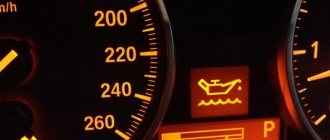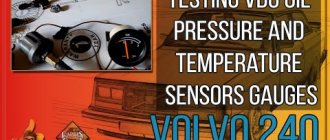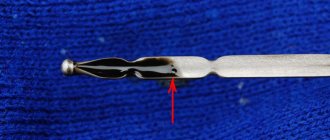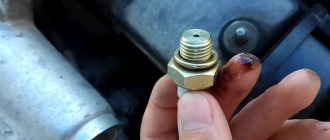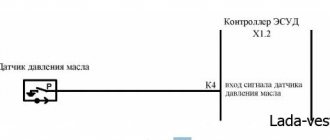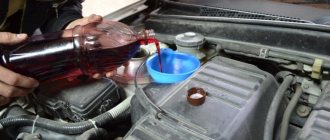Motor oil in an engine is a working fluid that protects parts from dry friction and cools heated surfaces. The lubricant also performs a cleaning function, flushes out contaminants and neutralizes aggressive chemical compounds.
In the lubrication system of an automobile internal combustion engine, engine oil is supplied to the loaded elements under a certain pressure. The specified pressure is created by the oil pump. In this case, deviations from the norm for this indicator, up or down, are a malfunction.
If oil pressure is low, the engine is subject to significant wear. High oil pressure leads to oil seals being squeezed out, gaskets and seals leaking, and lubricant is “thrown” into areas not intended for it.
In this article we intend to talk about what is normal oil pressure at idle speed of the engine and under load, for what reasons a change in pressure can occur and what it depends on, as well as how to find out the oil pressure in the engine.
The need to measure pressure
Oil pressure creates an oil film in the gap between the crankshaft journal and the journal bearing. When the pressure drops, this film disappears, resulting in oil starvation, friction between the parts of the unit increases, and the temperature rises. First of all, wear occurs on the crankshaft and other plain bearings. In the worst case scenario, the crankshaft may seize. Increased pressure also adversely affects engine performance. Seals, such as the front crankshaft oil seal, can be squeezed out, causing oil leakage, and again, leading to repairs.
Motor oils for worn-out internal combustion engines
In addition to new cars on the roads, there are those with mileage of several tens of thousands of kilometers. For cars manufactured in Western (Germany, France, Great Britain, Italy, Sweden, Czech Republic) and Eastern countries (South Korea, Japan, China), a mileage of 100 thousand km is not critical. The service life of modern vehicles often exceeds 200...300 thousand km. Domestic cars' mileage is also close to imported products. But for everyone, with use, the gaps still increase.
For vehicles with high mileage, lubricant manufacturers produce special oils. They contain additives that promote sealing in gaps. Working fluids, after being poured into the engine crankcase, ensure operation in conditions close to optimal.
What oil pressure should be in the engine?
Each brand has an internal combustion engine system based on specially developed designs. Therefore, the required pressure indicators are indicated in the service instructions for each specific vehicle. At idle it should be less than at operating speed, since at idle the pump rotation speed is lower. On average, the figures are approximately as follows:
- at idle (low) speed - 2 bar (0.2 MPa);
- at operating (high) speeds for different cars 4.5 - 6.5 bar.
How often should you measure your blood pressure and why?
Depending on the operating conditions, it is important to determine the frequency of measuring the pressure, since the oil pressure light may not light up for a number of reasons, and therefore you should not rely heavily on it. Therefore, it is better to choose a replacement interval that is individual for each vehicle and conditions of use.
In a gentle operating mode, you can limit yourself to generally accepted standards, according to which it is recommended to check the oil pressure level every 1-2 thousand km. For very infrequent trips, measurements can be taken once a month.
Powertrain Pressure Check Procedure
There is an indicator on the dashboard of the car that signals an emergency drop in pressure. It usually looks like an oil can. Sometimes this indicator may flash, in which case you should not postpone the inspection. It is better to immediately identify the problem and fix it. You can check the oil pressure yourself if you have some skills. To do this you need:
- Start the engine, warm it up so that the temperature readings are working, at least 90 degrees.
- Turn off the engine, open the hood and find the emergency sensor.
- Instead of an emergency pressure sensor, install a pressure gauge (to avoid doubts about the accuracy of the readings, it is better to buy the device from a trusted manufacturer). You may need an extension hose or adapter.
- Start the engine and check the idle pressure.
- Press the accelerator pedal to increase the speed to 5000 and check the pressure now at high speeds. If you are unable to measure your blood pressure yourself, you can contact a specialist.
Danger of incorrect pressure
All car manuals will say that the pressure should be normal. But it is not always specified how this parameter is measured, what it depends on and how to raise it if it has dropped, or how to reduce it if it has risen. And what does this norm even mean? Let's figure it out.
As you can see, there are a lot of questions. It is unlikely that I will be able to give a detailed description of literally each of them. That's why we need your help. If you have ever worked with engines like FE-E, 6G72, YaMZ 236, 238, or the same ZMZ 409, it would be a good idea to leave your comment.
As for what the correct pressure should be, I’ll say it simpler first. It shouldn't be high or low. Average Because:
Reasons for low blood pressure
If the pressure drops, it is necessary to determine why it dropped. There may be several reasons.
Late oil change
Over long runs, the oil loses its physical and chemical properties, which leads to its thickening and a decrease in the flow area of the oil channels. As a result, the pressure decreases, the lubricating properties decrease and the wear of the rubbing surfaces of the power unit increases.
Oil type does not comply with manufacturer's recommendations
In a modern engine, oil is not only a lubricant, but also the pressure compressed by the pump is used as an energy carrier to control various auxiliary devices installed in the engine. These are hydraulic compensators, phase regulators, and hydraulic chain tensioners. In this regard, the manufacturer pays special attention to the viscosity of the oil. It should be quite liquid, but not lose its lubricating properties. Therefore, using a different type of oil, different viscosity or poor quality may lead to a decrease in pressure in the oil system.
Antifreeze, exhaust gases or fuel getting into the oil
If antifreeze gets into the oil, this leads to the formation of an emulsion that does not have any lubricating properties. The pump is not able to compress this emulsion to the required pressure. If fuel gets into the oil, it dilutes very much and the required pressure is also not maintained. Exhaust gases can only enter the oil system through a broken piston crown, but in this case the engine will most likely stop and will not work.
Oil pump does not work
The pump maintains engine pressure by compressing oil in the housing. If there is wear on the pump or a malfunction of the pressure relief valve, all this will also lead to a drop in pressure.
Natural engine wear
During long-term operation, engine wear inevitably occurs, primarily the parts of the cylinder-piston group and the crank mechanism. Each manufacturer determines the engine mileage before major overhaul.
A decrease in pressure can be caused by such common reasons as insufficient oil level in the system or severely dirty oil filter. Such malfunctions can be eliminated quite quickly and easily on your own.
Result of checking
If the pressure gauge shows normal oil pressure in the power plant, but the control indicator continues to glow treacherously after connection, then the reason for its activity lies in its malfunction. Replace the sensor with a new one and enjoy your trips further.
High blood pressure
Causes
If you are lucky enough to encounter the problem of high blood pressure, then you need to figure out what caused it. This disease occurs for the following reasons:
Viscosity of motor oils at a temperature of - 20 degrees
- Using oil that is not suitable for the engine technical parameters. If you ignored the manufacturer's instructions and poured the first liquid with an excessively high viscosity into the engine, the problem will not be long in coming. It becomes especially relevant when using summer lubricants in winter.
- Obstruction of oil channels and filters. Oil pressure is affected by clogging of the lubrication system paths and filter elements of the structure. A large amount of soot, soot and metal shavings clog the channels through which the oil circulates. As a result, the same amount of liquid continues to move through the “cut down” system, increasing pressure inside it.
- Reducing valve malfunction. The valve does not provide the required dosage of fuel and lubricants and leaves in the system an excess amount of oil for the cycle. As a result, the free space required for effective functioning is reduced and the pressure increases.
- Malfunction of the bypass valve. Its main task is to supply working fluid from the pump to the channels of the lubrication system, bypassing the filter element if it is clogged. If there are malfunctions in its operation and it begins to leak oil while the filter is functioning, the pressure in the power plant increases.
- Exhaust valve defective. Exhaust gases must leave the structure and not accumulate in it. The pressure in the engine lubrication system may increase due to the failure of the exhaust valve: the gas-air mixture will fill the crankcase and increase the pressure of the oil lubrication.
Consequences
If the pressure gauge measures the pressure and reveals increased oil pressure, the problem must be solved as quickly as possible, otherwise the following consequences may occur:
- Destruction of sealing elements. Excessive oil pressure begins to squeeze out excess working mixture through the “weak points” of the system - oil seals and rubber seals. As a result, these elements will collapse and fail.
- Increased oil consumption. The formation of a large number of leaks leads to constant oil losses.
- Increased consumption of fuel and lubricants. To create such high pressure, the oil pump requires a large amount of energy and, as a result, an additional dose of the fuel mixture.
- Damage to spark plugs. When the circulation of lubricant in the engine compartment is disrupted, its excess penetrates where it did not penetrate before - into the combustion chambers. Here the oil begins to come into contact with the electrodes of the spark plugs, which makes it impossible to form a spark to ignite the air-fuel mixture. It is impossible to start the engine with flooded spark plugs.
- Destruction of piston skirts. There is nothing to add here, because it will not be possible to put them back together. If a similar situation arises on the highway, getting to the nearest service center will not be easy at all.
Elimination
In order to return the car to its previous performance, it is necessary to carry out the following measures:
Checking the engine oil level
- If the dipstick detects a high level of lubrication fluid, remove excess fluid through the drain plug or using a vacuum pump.
- If the technical parameters of the engine oil do not meet the requirements of the car manufacturer, it is necessary to replace all the fluid. You need to pay attention not only to viscosity, but also to the high- and low-temperature capabilities of fuels and lubricants.
- If the filter element is clogged, it must be replaced.
- Using special flushing agents, get the lubrication system in order. Carbon deposits, soot and other contaminants should not be deposited on the inner sides of the oil channels.
- Inspect and replace system valves if necessary. When conducting periodic technical inspections, pay special attention to them to prevent possible engine failures.
Low pressure
Causes
If excess pressure is a relatively rare problem, then every fifth driver encountered low pressure in the oil system. There can be many reasons for the problem, so let’s focus on the main ones:
- Unsuitable liquid. The petroleum products market is huge, so often the driver buys oil with inappropriate “capabilities”, relying on the advice of friends or the recommendations of sellers. It should be remembered that only the liquid that has passed the automaker’s tests should splash under the hood of your iron friend.
- Formation of leaks. Depressurization of the system, which occurred due to the formation of multiple cracks and chips in the mechanisms of the power plant, as well as the destruction of its sealing elements, will lead to a drop in the level of oil lubrication and the impossibility of creating the required level of pressure inside the system.
- Pumping unit breakdown. In cases where there is a malfunction of the pump itself, there is a noticeable decrease in oil pressure in the system and the characteristic indicator lights up.
- Oil dilution. Mixing oil with the fuel mixture is a dangerous problem for the engine. To diagnose it, you need to disconnect the crankcase ventilation pipe and smell the exhaust. Does it smell like fuel? This means that the integrity of the structure is compromised and part of the fuel and lubricants penetrates into the work area. By the way, gasoline neutralizes the properties of the oil and leads to its obsolescence.
Consequences
Neglecting the rules for selecting oil will damage the engine: a base that is too liquid will not be able to create the required pressure inside the unit, but will only drain from the surfaces of the parts, leaving them without proper protection. All structural mechanisms will begin to experience excessive overheating, and the temperature inside the propulsion system will steadily increase. Ultimately, each of its elements will be deformed under the influence of serious overloads, and subsequently completely destroyed. Is it worth talking about expensive repairs, without which the car will no longer be able to drive?
Elimination
The main reason for the pressure drop is due to high oil consumption.
This may be due either to damage to the structure and the formation of numerous leaks, or to the use of a low-quality mixture that works as a waste.
In the first case, the owner of the problematic vehicle needs to inspect the entire power structure, find its weak points and repair them. In the second, it is necessary to select a lubricant that meets the requirements of the car manufacturer. Before filling it, it is recommended to flush the engine with special oils. The pressure inside the installation is directly dependent on the viscosity of the composition used - which is why it is necessary to approach the issue of choosing motor oil very carefully.
How to increase engine oil pressure?
If after measurement it turns out that the pressure in the system is low, you must perform the following actions:
- First, be sure to check the oil level and the degree of contamination of the oil filter. If necessary, replace the filter and add oil to the required level. Oil and filter changes should occur at the intervals recommended by the manufacturer.
- The next step is to check the pressure relief valve. It needs to be removed, disassembled, inspected, checked for the integrity of the spring and the presence of burrs.
- If everything is in order here, you need to check the oil pump. Remove it, disassemble it, and do a visual inspection of the rubbing surfaces. If the pump is faulty, repair it if possible, and if it cannot be repaired, replace it.
- If checking all these points does not reveal any malfunctions, then most likely the cause of the drop in pressure is wear of the crankshaft and plain bearings. Here it is necessary to do a major overhaul of the engine.
Attention! If the pressure measurement shows that it is low, you must immediately stop using the car, since the engine has already suffered from overheating and friction.
It can be restarted only after the fault has been identified and eliminated. If the indicator on the dashboard lights up while driving somewhere along the way, on the highway, it is better to call a tow truck. The cost of tow truck services will be significantly lower than the investment in major repairs.
Periodically measuring the pressure in the oil system will help extend the life of the engine. With this simple procedure, you will be able to identify the problem in time and avoid the cost of expensive repairs.
Motor oil is vital for the proper operation of the engine. Carefully monitor its condition, regularly check the level, monitor for chip impurities, and monitor the mileage of the car. Carry out vehicle maintenance in a timely manner, install high-quality oil filters, fill in oil that is suitable specifically for your car, and you will not experience problems with pressure in the engine oil system.
Diagnostics of the lubrication system
Modern engines are equipped with sensors that are located in different parts. During operation, the driver does not see information about which systems are operating and in what mode. Information comes to the control computer in the form of lighting individual indicators. They indicate the occurrence of certain errors in work.
If a certain failure occurs, the message “Check engine” appears, it signals that a failure is occurring. It is not advisable to use such messages.
When the engine wears out, such an inscription may indicate a decrease in pressure. Therefore, if the driver sees such a message, then diagnostics need to be carried out.
The motors have special connectors to which you can connect a laptop. Special programs for analyzing engine operation can be downloaded from the Internet. Each type of internal combustion engine has its own diagnostic programs.
Diagnostics are performed in the following sequence
- The connector is connected to the computer.
- The required program is activated.
- On a cold engine, the zero performance reading is determined.
- The engine starts.
- After warming up to normal thermal conditions, the program automatically reads information from sensors that were installed during manufacture.
- Among the information read, data on idle pressure is obtained.
- For some internal combustion engine models and software, you can check operation in engine acceleration or braking modes. Therefore, more complete information about the state of the systems is obtained.
- In most programs, in addition to the general condition, you can clarify how well the oil used corresponds to the engine operating conditions.
Based on the type of errors that are recorded after diagnostics, you can decide what is required for a particular motor. If the mileage is short, then most often normal operation is restored when consumables are replaced. The lubrication system will begin to show acceptable performance when new lubricant is added.
What does the indicator affect?
If in old engines the only task of motor oil was to prevent wear of parts, today the range of functions has increased significantly.
Now the viscous composition removes heat from hot components and performs the function of hydraulics in various car mechanisms:
- in hydraulic compensator valves;
- chain and belt tensioners;
- couplings and so on.
If the oil pressure in the engine is too low, oil starvation occurs, followed by accelerated engine wear. Malfunctions in the operation of the above hydraulic systems are also possible. All this inevitably leads to serious malfunctions and expensive repairs.
Oil starvation causes accelerated wear of spare parts.
For example, there are cases when the hydraulic tensioner of the timing chain fails. And subsequently, due to a collision between the piston and the valves, the engine may no longer be repairable. Requires purchasing a new one. This will bring many unplanned costs.
The vehicle dashboard is specially equipped with a lamp that indicates a decrease in the normal pressure level. In some cases, an exact indicator is indicated. You can measure the indicator yourself, but you will need a special device for checking the oil pressure in the engine - a pressure gauge.
Do not forget that insufficient and excessive engine oil pressure is different for each car and may differ from the accepted standards of another brand.
